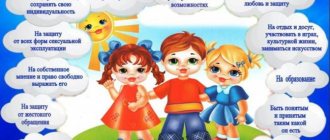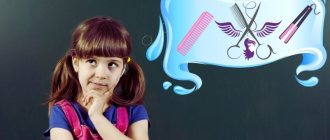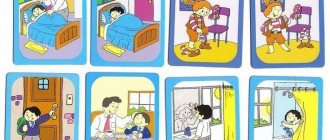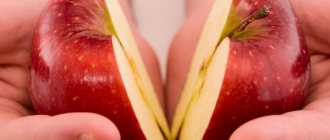The purpose of the didactic game “What’s extra”
The goal is to develop the skill of classifying objects according to key features, visual analysis and generalization.
Tasks:
- improving the ability to classify;
- expanding your horizons and ideas about the world around you;
- fostering cognitive interest;
- enrichment of individual vocabulary;
- improving visual perception;
- development of memory, intelligence, ability to think figuratively and logically.
MAGAZINE Preschooler.RF
A game to develop logical thinking “The Fourth Wheel”Arkhipova Elena Alexandrovna
Invite your child to find an extra object on the card and explain his choice. Do not rush to suggest the correct answer, from your point of view. Sometimes children's logic finds very interesting solutions.
This game is for children aged 5-7 years to develop thinking, attention and to consolidate general concepts.
Goals:
- Development of thinking and attention.
- Consolidation of general concepts: vegetables, fruits; clothes, shoes; wild and domestic animals, food; furniture; insects; land, water, air transport.
Progress of the game:
Show the child the card and say: “Look, there are 4 pictures drawn here, 3 of them fit together, they can be called in one word, and the 4th is extra. Which? Why do you think so?
Types of provocations:
- to size
- by color
- according to form
- by style
- in count
- according to material
For example:
No. 1. Dress, shirt, coat, shoes.
Shoes are superfluous, since they are shoes, and a dress, shirt and coat are clothes.
No. 2 Turnips, corn, pear, pepper.
The pear is extra since it is a fruit, and the turnips, corn and peppers are vegetables.
No. 3. Cucumber, apple, peas. potato.
An apple is superfluous, since it is a fruit, and cucumber, peas, and potatoes are vegetables.
No. 4. Pear, lemon, pumpkin, apple.
Pumpkin is superfluous, since it is a vegetable, and pear, lemon, and apple are fruits.
No. 5. Wolf, squirrel, fox, cow.
A cow is superfluous, since it is a domestic animal, and a wolf, a squirrel, a fox are wild animals.
No. 6. Cat, bear, hare, tiger.
A cat is superfluous, since it is a domestic animal, a bear, a hare, a tiger are wild animals.
No. 7. Kefir, butter, cheese, cookies.
Cookies are superfluous, since they are a flour product (bakery), and kefir, butter, and cheese are dairy products.
No. 8. Potatoes, apple, tomato, cabbage.
An apple is superfluous, since it is a fruit, and potatoes, tomatoes, cabbage are vegetables.
No. 9. 3 strawberries, 4 cherries, 4 plums, 4 gooseberries.
3 strawberries, since there are 3 of them, and the rest are 4 each.
No. 10. Bus, trolleybus, tram, sprinkler.
A watering machine is superfluous, since it is a special equipment, and a bus, trolleybus, tram is a passenger transport.
No. 11. Butterfly, bee, 2 beetles, mosquito.
2 beetles are extra, since there are 2 of them, the rest of the insects: butterfly, bee, mosquito, one each.
No. 12. Chanterelles, fly agaric, porcini mushroom, russula.
Fly agaric mushrooms are superfluous, since they are not edible, poisonous mushrooms; other mushrooms can be eaten.
No. 13. Goat, horse, elk, sheep.
The elk is superfluous, since it is a wild animal, and the goat, horse, and sheep are domestic animals.
No. 14. Elk, bear, pig, hare.
The pig is superfluous, since it is a domestic animal, and the elk, bear and hare are wild animals.
No. 15. Table, wardrobe, sofa, chair.
The sofa is superfluous, since it belongs to upholstered furniture, the table, wardrobe, chair - to wooden.
No. 16. Steam locomotive, helicopter, car, bus.
A helicopter is superfluous, since it is air transport, and a steam locomotive, a car and a bus are ground transport.
No. 17. Cow, horse, pig, hedgehog.
The hedgehog is superfluous, since it is a wild animal, and the cow, horse and pig are domestic animals.
No. 18. Plane, ship, boat, sailboat.
An airplane is superfluous, since it is an air transport, and a ship, a sailboat is a water transport.
No. 19. Carrot, lemon, pear, apple.
Carrots are superfluous, since they are vegetables, and lemons, pears, and apples are fruits.
No. 20. Banana, eggplant, potatoes, beets.
Banana, since it is a fruit, eggplant, potatoes, beets are vegetables.
| Next > |
On the topic: methodological developments, presentations and notes
A didactic game is a multifaceted, complex pedagogical phenomenon: it is both a playful method of teaching preschool children, a form of learning, and independent play.
By environmental education of children we must understand, first of all, the education of humanity, that is, kindness, a responsible attitude towards nature, and towards the people who live nearby, and towards the descendants of whom.
Developed by: Salamatina Irina Borisovna teacher of GBDOU No. 48 of the Kirov region with peas or beans). St. Petersburg Description of the game: Goal: development of fine motor skills, tactile sensitivity.
Educational didactic games.
We develop fine motor skills, learn to connect parts of an object into one whole, name an object, determine its color. We develop memory, thinking, attention, increase vocabulary. Fasten p.
This game will help a 6-7 year old child become familiar with heraldry. The game contains two games that will interest any preschooler. The didactic game “Flags of the World” will allow the child to learn not only flags.
Sound culture of speech in a fascinating incident with lost pets.
Source
“This mysterious space” (lesson for children of the preparatory group)
Integration of educational areas: “Cognition” (formation of a holistic picture of the world), “Communication”, “Socialization”, “Music”.
Types of children's activities: playful, productive, communicative, cognitive and research.
Goal: Expanding and systematizing basic knowledge about space as an integral part of the Earth.
Objectives: To reinforce the concepts of “space” and “outer space” in children.
The ability to explain what the “Solar System”, “star”, “planet” is.
Develop phonemic awareness and syllabic reading skills.
Develop children's logical thinking (analysis and synthesis); the ability to classify and combine objects according to some basic, essential characteristic.
Develop memory.
Learn to answer specific questions clearly and concisely.
Foster a sense of purpose, camaraderie, comfort and self-confidence.
Planned results: knows how to maintain a conversation, expresses his point of view; has self-service skills, actively and kindly interacts with the teacher and peers in solving gaming and cognitive problems.
Preliminary work: reading and looking at books, illustrations about space and astronauts, memorizing poetry, drawing a rocket, space technology, planets, visiting the space room, a model of the solar system, role-playing games, a model of “Seasons”.
Materials: Cut-out pictures with a space plot, an exhibition of books about space, photographs of astronauts, emblems (color symbols), cards with words, a model of the solar system, a model of a rocket.
Contents of organized children's activities
Progress of the lesson
1. Our activity today is not quite ordinary. So that you understand what we are going to talk about today, please look at the table.
(There are cut pictures on the table.)
Game "Collect the picture"
Let's divide you into two groups and try to collect pictures.
(The teacher prepares pictures that depict objects or a plot related to the topic of the lesson. A sheet of colored paper is glued to the back of each picture, then each picture “shirt” has its own color. Then the pictures are cut into fragments so that the number of fragments coincides with number of children. Fragments of pictures are laid out on the table face up.
When all the pictures are collected, the children look at them and make guesses about the topic of the lesson.)
- What do you think we will talk about today?
- How did you guess?
That's right, well done!
2. Exhibition of books about space, photographs of astronauts.
The mysterious world of stars and planets has attracted the attention of people since ancient times. But it became closer and more accessible only with the penetration of man into space. Every year in April, our country celebrates Cosmonautics Day.
- Who can tell me why?
- What was the name of the first person to fly into space?
(Find and show Gagarin’s portrait.)
There is a monument to him in Moscow, it is located on Yu.A. Square. Gagarin. And it looks like a silver rocket flying into space.
- But before people were launched into space, who was the first to go there?
- Why were animals launched into space first?
Not only men, but also women have been in space.
- What was the name of the first woman astronaut? (show her photo).
- What other astronauts do you know, name them?
- What do you think an astronaut should be like?
To become such, astronauts have to train a lot on the ground.
There is a special space training center for astronauts.
- Who can tell me what it's called?
- Where is?
3. Emblems (with symbols of space technology).
Guys! Would you like to become an astronaut?
This is why we will now take a training course and see which of you can become a real astronaut. For today I will become your instructor and conduct several training exercises. So! Since you will be astronauts today, let's choose one emblem with the color you like.
4. Assignments.
1. I will say a word, you must repeat it and explain its meaning:
(fame cards)
spacesuit cosmodrome star
centrifuge lunar rover astronaut.
2. You have already said what a centrifuge is and what it is needed for...
(swivel chair).
I would like to invite you to take a "centrifuge" test. But you should not only feel the effect of rapid spinning, but also hear what I will say.
Game "Fourth wheel"
Your task is to hear and name a word that does not relate to space:
Gagarin, Titov, Pushkin, Leonov, lunar rover, satellite, rocket, helicopter, meteorite, kite, star, comet, globe, Moon, Sun, Venus.
- Prove why?
3. We said that astronauts are strong, brave, smart people...
For all this, they must not only train, but also eat well.
(tray with various foods and tubes).
- Tell me, why is some food on the plate in sliced form, while others are in tubes?
(Children sit at the table, in front of each child there are 2 “tubes.”)
Each of you has 2 tubes on the table: white and yellow. On one of the tubes there is a drawing and an inscription, and on the other there is an encrypted word that must be read.
a) Take a “tube” with a picture. Look at what is drawn on it and read what word is written next to it (an apple is drawn, it is written: puree)
- What does this mean? (applesauce)
b) On the second tube we read the encrypted word:
5. Physical exercise
The sound "u" is an airplane.
Well done! We trained physically and found out what they can eat in space. Now we can make space flight. A rocket is waiting for us.
(Rocket model.)
- What can astronauts do in space?
(The sound of a rocket taking off is heard.)
6. Go to the space room.
- Guys, why is it so dark in space?
Dark Space Experience
(Book by O.V. Dybin “The Unknown is Nearby” p. 111.)
Now we know why space is so dark.
- But what do we see through the darkness of space?
- What is the Sun?
- What are stars made of?
- Why do we need the Sun?
Our star - the Sun - has its own family. (model of the solar system)
- What does the Sun family consist of?
- How many are there?
- What are planets made of?
Experiment “Let's see if the Sun imparts heat equally to its planets”
(Book “The Unknown is Nearby” p. 166.)
- So which planet receives the most solar heat?
- And on what planet there is never sun and it is very cold there? Why?
- Which planet is made of red dust and rocks?
- Which one is considered the largest?
- What can you say about this planet?
- Find and show the planet we live on.
- Why is there life on planet Earth?
Our space flight has come to an end. The time has come for us to return to Earth.
7. Summary.
Today you completed all the tasks very well. And it’s possible that after our lesson, some of you will want to become an astronaut. But to become a real astronaut:
- What do you think needs to be done?
- And if you meet someone in space, what can you tell about our planet Earth?
- What is she like?
Our lesson has come to an end. Thank you all very much. Select the circle with the color you like again. Take it as a souvenir of our lesson today.









